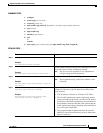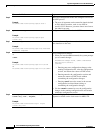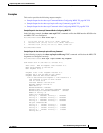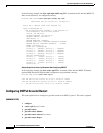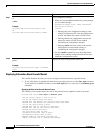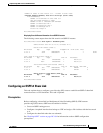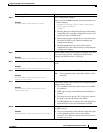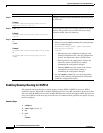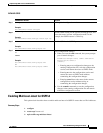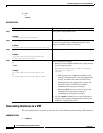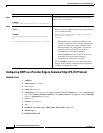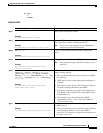
Implementing OSPF on Cisco IOS XR Software
How to Implement OSPF on Cisco IOS XR Software
RC-235
Cisco IOS XR Routing Configuration Guide
OL-14356-01
Step 5
end
Example:
RP/0/RP0/CPU0:router(config-if)# end
Saves configuration changes.
When you issue the end command, the system prompts you
to commit changes:
Uncommitted changes found, commit them before
exiting(yes/no/cancel)?
[cancel]:
• Entering yes saves configuration changes to the running
configuration file, exits the configuration session, and
returns the router to EXEC mode.
• Entering no exits the configuration session and returns
the router to EXEC mode without committing the
configuration changes.
• Entering cancel leaves the router in the current
configuration session without exiting or committing the
configuration changes.
Step 6
router ospf instance-id
Example:
RP/0/RP0/CPU0:router(config)# router ospf isp
Enables OSPF routing for the specified routing process, and
places the router in router configuration mode. In this
example, the OSPF instance is called isp.
Step 7
vrf vrf-name
Example:
RP/0/RP0/CPU0:router(config-ospf)# vrf vrf1
Creates a VRF instance and enters VRF configuration
mode.
Step 8
router-id {router-id}
Example:
RP/0/RP0/CPU0:router(config-ospf-vrf)#
router-id 192.168.4.3
Configures a router ID for the OSPF process.
Note We recommend using a stable IPv4 address as the
router ID.
Step 9
redistribute bgp process-id
Example:
RP/0/RP0/CPU0:router(config-ospf-vrf)#
redistribute bgp 1
Redistributes OSPF routes from the one routing domain to
another routing domain.
• This command causes the router to become an ASBR
by definition.
• OSPF tags all routes learned through redistribution as
external.
• The protocol and its process ID, if it has one, indicate
the protocol being redistributed into OSPF.
• The BGP MED value is copied to the LSA metric field
when BGP VPN routes are redistributed to OSPF.
Step 10
area area-id
Example:
RP/0/RP0/CPU0:router(config-ospf-vrf)# area 0
Enters area configuration mode and configures an area for
the OSPF process.
• The area-id argument can be entered in dotted-decimal
or IPv4 address notation, such as area 1000 or
area 0.0.3.232. However, you must choose one form or
the other for an area.
Command or Action Purpose



